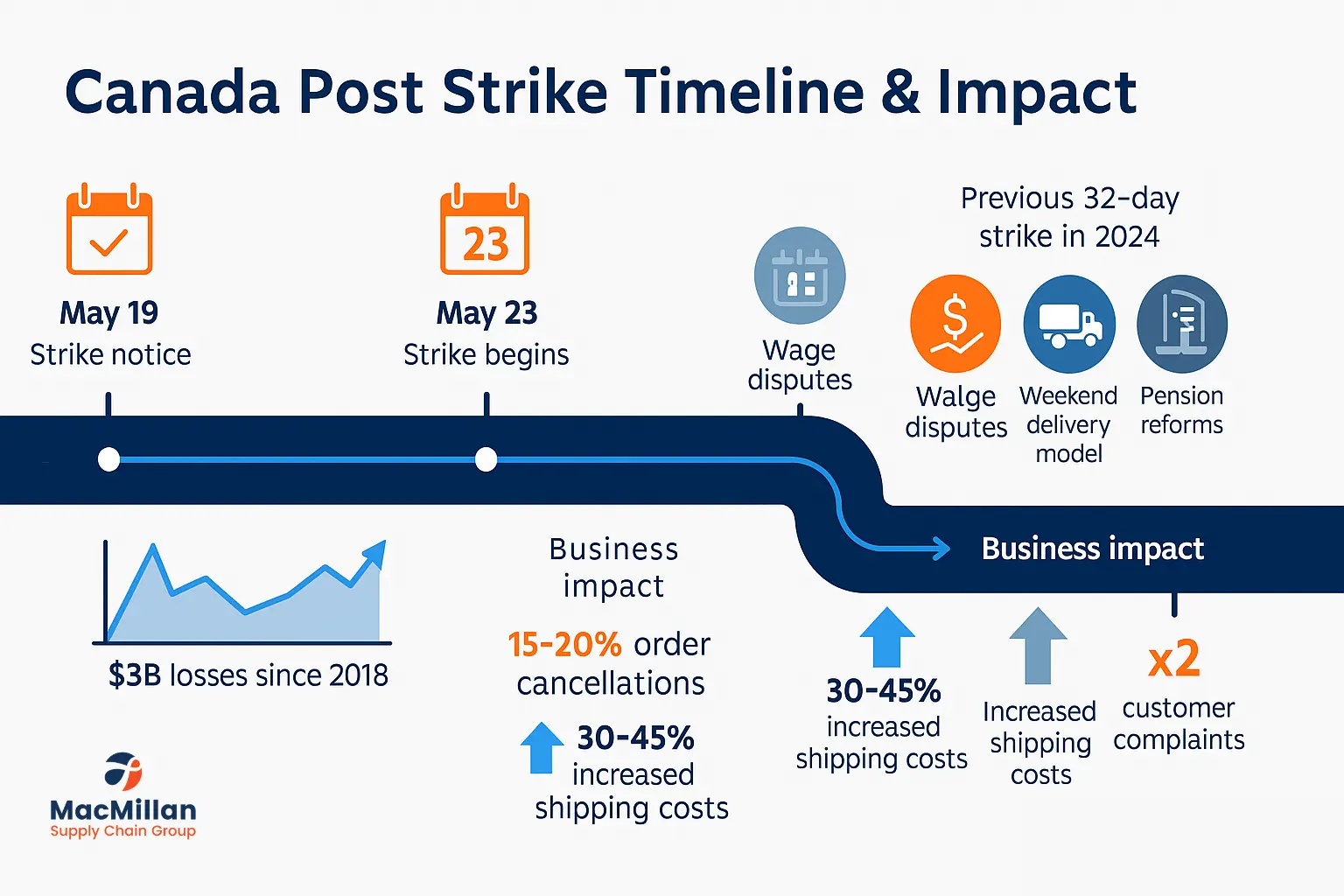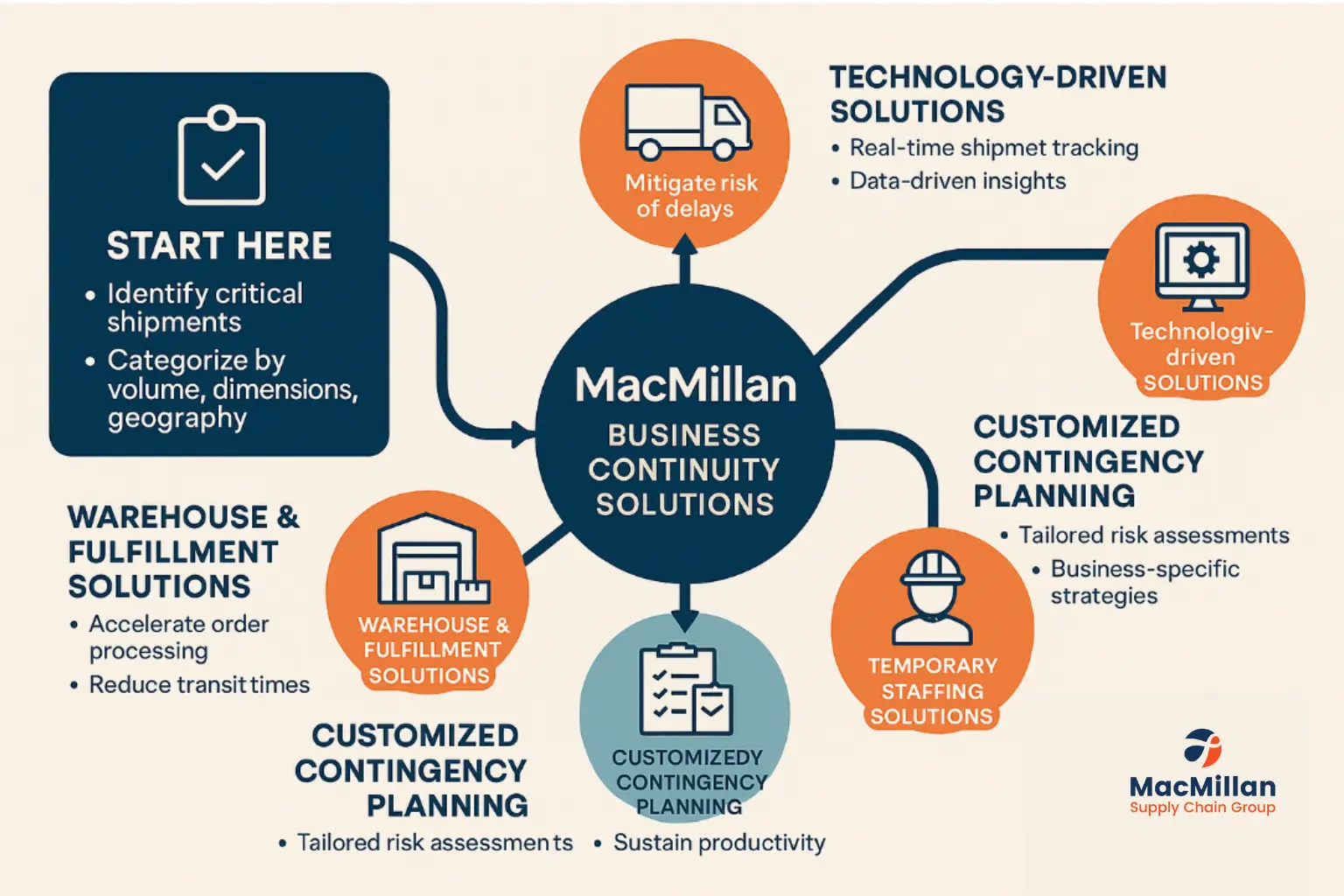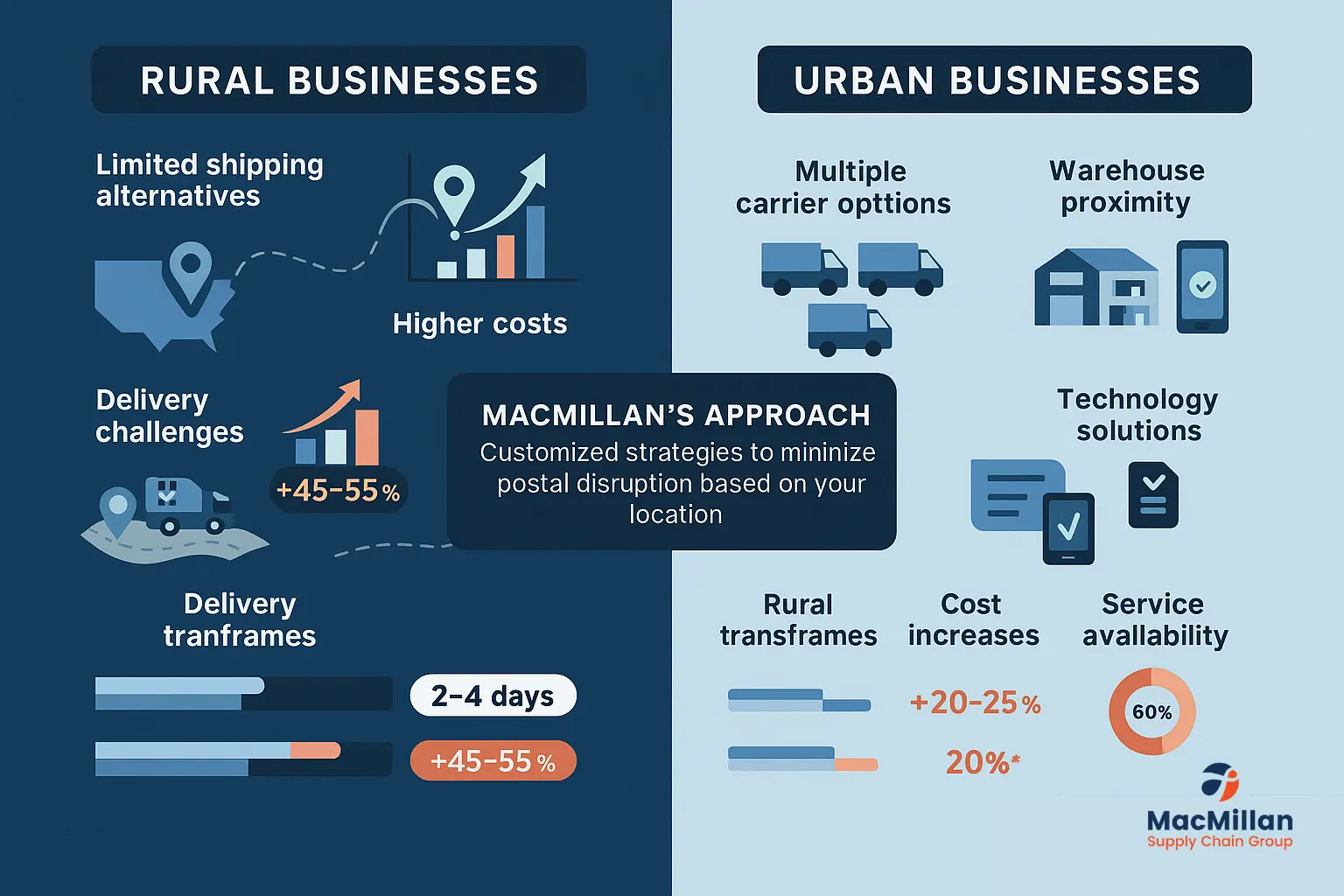Canada Post Workers Strike: What It Means for Your Business
A Quick Summary and Overview
The Canada Post workers strike has threatened to stop mail and parcel delivery across the country by issuing a strike notice for May 23, 2025. Unresolved disagreements over pay, job security, and Canada Post’s financial viability are the root cause of this strike. Businesses need to be ready for major shipping disruptions, as Canada Post has lost $3 billion since 2018 and has needed a $1 billion government bailout. The reasons behind the strike, its possible effects, and how companies can continue to operate despite the postal service outage with the support of logistics partners like MacMillan Supply Chain Group are all covered in this article.
Introduction
Understanding the Canada Post Workers Strike
The CUPW declared on May 19, 2025, that a nationwide strike would start on May 23 at midnight local time. Following a 32-day strike in late 2024, this is the second significant labor disruption in six months. This announcement causes a great deal of uncertainty for companies that depend on Canada Post to ship goods, send bills, or collect payments.
Wage increases to offset inflation, opposition to increased use of temporary workers, resistance to pension reforms, and disputes over weekend delivery models are some of the main issues at the heart of the strike. The Industrial Inquiry Commission (IIC) recently deemed the Crown corporation “effectively insolvent,” indicating that Canada Post is facing significant financial difficulties.
You must be aware of what is going on and know how to get ready as a manager or owner of a business. To keep your supply chain running during this postal service outage, let’s dissect the situation, look at how it might impact your business, and consider potential solutions.
Canada Post Workers Strike’s Fundamental Causes
Financial Crisis and Modernization Initiatives
The financial difficulties faced by Canada Post did not occur suddenly. Due to a 63% decline in mail volumes from their peak in 2018, the Crown corporation has lost about $3 billion. The expenses of sustaining nationwide service have surpassed revenues, even though e-commerce has led to an increase in parcel delivery.
The government bailed out Canada Post with $1 billion at the beginning of 2025. The Industrial Inquiry Commission issued a report shortly after that included suggestions for resolving the financial insolvency:
Close underperforming rural post offices and replace daily door-to-door mail delivery with community mailboxes.
To meet the demand from e-commerce, introduce part-time weekend parcel couriers.
The management of Canada Post embraced these suggestions as a “roadmap for modernization.” However, CUPW rejected the report, arguing it prioritizes cost-cutting over worker rights and public service ideals.
“These changes would fundamentally alter Canada’s postal service while creating more precarious employment,” said the CUPW president in a recent statement. “We cannot accept a plan that undermines job security and service quality for Canadians.”
The current Canada Post workers strike notice is the result of a perfect storm created by the conflict between worker concerns and modernization requirements. Businesses can better understand why a speedy resolution might be challenging by comprehending these underlying causes.
 Important Bargaining Points in the Canada Post Workers Strike
Important Bargaining Points in the Canada Post Workers Strike
Models of Weekend Delivery and Wage Conflicts
A number of significant issues that directly impact postal workers and the future of Canada Post services have caused the collective bargaining process to stall.
The weekend delivery model represents one of the most contentious points. With e-commerce driving demand for seven-day delivery, Canada Post wants to introduce flexible part-time workers for weekend shifts. CUPW strongly opposes this plan, insisting on full-time positions with benefits to prevent what they call “gig economy precarity.”
Another significant point of contention is wage demands versus austerity measures:
To combat inflation, CUPW wants wage increases of 5% per year; management only offers 2% raises, citing budgetary constraints; the difference amounts to millions of dollars in extra expenses for a system that is already losing money.
The sustainability of pensions is still a third important concern. Canada Post wants to switch from defined-benefit pensions, which provide a fixed retirement income, to hybrid plans, which increase flexibility. Employees worry about less retirement security, while management cites growing pension obligations as support for changes.
These disputes draw attention to the core problem: how to update a traditional mail service for the digital era while safeguarding the interests of employees. These disputes have a direct impact on shipping costs and service reliability for companies that depend on mail delivery.
Effect on Businesses in Canada
Disturbances in the Supply Chain and Shipping Delays
Businesses across Canada will face immediate difficulties if the May 23 Canada Post workers strike goes ahead. Small and medium-sized businesses that depend on reasonably priced postal shipping options will be especially at risk.
The biggest disruption might be felt by e-commerce companies. Online retailers reported during the last strike in late 2024:
-
Order cancellations are up 15–25%
-
Twofold increase in customer service complaints
-
30-45% increase in shipping costs when using private carriers
Businesses in rural areas face even more difficulties. Canada Post is the only reasonably priced shipping choice in a lot of isolated communities. Other carriers may not offer service in these areas or may charge exorbitant prices that make shipping financially unfeasible.
The timing couldn’t be worse for companies that accept or send payments via mail. The final week of May is usually when month-end invoices and payments take place, which could cause cash flow issues for businesses that haven’t switched to electronic payments.
If manufacturing and supply chain companies receive parts or materials via Canada Post, they may also face inventory issues. Systems for just-in-time inventory are especially susceptible to shipping delays, which could result in production halts or slowdowns.
Businesses can create backup plans before the strike starts by being aware of these possible effects. Even in the midst of this postal service uncertainty, you can minimize operational disruptions and preserve customer satisfaction by being well-prepared.
 Common Problems with the Topics
Common Problems with the Topics
Misconceptions and Challenges During Postal Strikes
A number of significant issues that directly impact postal workers and the future of Canada Post services have caused the collective bargaining process to stall, leading to the current Canada Post workers strike.
The weekend delivery model represents one of the most contentious points. With e-commerce driving demand for seven-day delivery, Canada Post wants to introduce flexible part-time workers for weekend shifts. CUPW strongly opposes this plan, insisting on full-time positions with benefits to prevent what they call “gig economy precarity.”
Another significant point of contention is wage demands versus austerity measures:
To combat inflation, CUPW wants wage increases of 5% per year; management only offers 2% raises, citing budgetary constraints; the difference amounts to millions of dollars in extra expenses for a system that is already losing money.
The sustainability of pensions is still a third important concern. Canada Post wants to switch from defined-benefit pensions, which provide a fixed retirement income, to hybrid plans, which increase flexibility. Employees worry about less retirement security, while management cites growing pension obligations as support for changes.
These disputes draw attention to the core problem: how to update a traditional mail service for the digital era while safeguarding the interests of employees. These disputes—now central to the Canada Post workers strike—have a direct impact on shipping costs and service reliability for companies that depend on mail delivery.
Our Solutions
The Method Used by MacMillan Supply Chain Group to Address Postal Disruptions
We at MacMillan Supply Chain Group are aware of the difficulties that companies encounter when Canada Post employees go on strike. Even in situations where traditional postal services are not available, our all-inclusive logistics solutions can assist in preserving the integrity of your supply chain during events like the Canada Post workers strike.
Network of Diversified Carriers
Our clients now have options beyond Canada Post thanks to the connections we’ve made with numerous regional and national carriers across the country. This diversification of carriers enables us to:
-
Choose the best carrier for your shipping requirements
-
Negotiate volume discounts that are unavailable to individual companies
-
Use specialized regional partners to offer services in rural areas
-
Despite postal disruptions, adhere to regular delivery schedules
For instance, we swiftly switched a Toronto-based e-commerce client’s packages to a mix of regional carriers and our own last-mile delivery network when they encountered shipping issues during the 2024 strike, preserving 98% of their typical delivery performance.
Warehouse and Fulfillment Solutions Amid the Canada Post Workers Strike
Businesses have flexible storage and fulfillment options during postal disruptions thanks to our well-located warehouses throughout the Greater Toronto Area:
-
Delivery times are shortened when inventory is kept near important markets
-
Pick-and-pack services remove bottlenecks in internal fulfillment
-
Cross-docking capabilities expedite transit
-
Bulk breaking services reduce shipping expenses
By temporarily moving inventory to our Mississauga warehouse, eliminating delivery times, and lowering shipping costs in comparison to their prior Canada Post arrangements, one home goods retailer was able to avoid major disruption during the most recent strike.
Solutions Driven by Technology
During shipping delays, our in-house logistics technology helps companies stay visible and in control:
-
Automatic carrier selection based on cost, speed, and dependability
-
Real-time tracking across multiple carriers from a single dashboard
-
Comprehensive analytics to find areas for optimization
-
Integration with well-known e-commerce sites to process orders quickly
Customized Contingency Planning During the Canada Post Workers Strike
Prior to postal disruptions, we collaborate with companies to create customized backup plans:
-
Finding important shipments that need to be handled with priority
-
Setting up alternate delivery procedures for items that must be delivered quickly
-
Developing templates for customer communications to control expectations
-
Creating cost-effective shipping options for various situations
For example, during the postal disruption, we assisted a distributor of medical supplies in creating a tiered shipping strategy that gave priority to deliveries of critical medical supplies while employing more affordable options for less urgent items.
Temporary Staffing Solutions
We provide the following services to companies that manage their own shipping but require extra assistance during postal outages:
-
Temporary logistics staff to handle the complexity of shipping
-
Instruction in alternate shipping systems and techniques
-
On-site experts to streamline shipping processes
-
Pooled resources for several customers to keep expenses under control
MacMillan Supply Chain Group assists companies in preserving business operations in the face of postal service interruptions by putting these all-inclusive solutions into practice. Our strategy emphasizes cost-effectiveness, flexibility, and dependability to make sure your supply chain is robust even in the event that Canada Post services are interrupted by a Canada Post workers strike.
 How to Implement Solutions
How to Implement Solutions
Preparing Your Business for the Canada Post Strike
Businesses must move swiftly to put in place efficient backup plans as the May 23 Canada Post workers strike draws near. Here are some strategies for collaborating with MacMillan Supply Chain Group to preserve the integrity of your supply chain amid this postal service outage.
First, quickly evaluate your shipping requirements. Determine which shipments are essential and which can wait if needed. Sort your shipping needs according to:
-
Volume and frequency
-
Weight and dimensions of the package
-
The necessary delivery timeframe
-
Distribution by geography (rural vs. urban)
This information helps us create a customized solution that addresses your specific needs rather than a one-size-fits-all approach.
Next, think about making a short-term change to your inventory management plan. Before the strike starts, think about creating a small buffer of necessary items if you usually rely on just-in-time inventory. If you’re short on space, MacMillan’s warehouse facilities can help you store this extra inventory.
Update your customer communications and website for e-commerce companies to set realistic expectations. We can assist you in creating communications that outline possible hold-ups and provide substitute shipping choices that we will handle for you.
These solutions don’t have to be difficult or costly to implement. From full logistics takeovers to specialized assistance for particular shipping issues, MacMillan Supply Chain Group provides adaptable engagement models that grow with your needs.
Don’t put off creating your backup plan until the strike starts. To arrange a consultation, call MacMillan Supply Chain Group at (416) 548-8100 or visit our website at www.macmillanscg.com. In spite of the Canada Post disruption, our logistics specialists will assist you in creating and putting into practice a tailored solution to keep your company operating.
Keep in mind that companies that get ready now will have an advantage when the strike starts. During this difficult period, let MacMillan Supply Chain Group be your partner in preserving supply chain resilience.
Follow us on LinkedIn for real-time tariff updates
FAQS
The Canada Post workers strike is scheduled to begin at 12:01 AM local time on May 23, 2025, if no agreement is reached before then. CUPW issued the strike notice on May 19, giving the legally required notice period.
Some essential services typically continue during postal strikes. Government benefit cheques (like Employment Insurance, Old Age Security, and Canada Pension Plan payments) usually get delivered. However, regular mail, parcels, and business correspondence face significant delays or complete stoppage.
The duration is uncertain. The previous strike in late 2024 lasted 32 days before government intervention. Strikes can end through negotiated agreements, binding arbitration, or back-to-work legislation from the government. Businesses should prepare for a disruption lasting at least 2-4 weeks.
The key issues include disagreements over weekend delivery models (Canada Post wants part-time weekend workers while CUPW wants full-time positions), wage increases (workers want 5% while management offers 2%), pension reforms (shifting from defined-benefit to hybrid plans), and job security concerns related to automation and part-time work.
E-commerce businesses that rely on Canada Post will experience shipping delays, potentially leading to order cancellations and customer service challenges. During the 2024 strike, online retailers reported 15-20% increases in cancellations and shipping costs rising 30-45% when switching to private carriers.
Yes, rural areas typically face greater challenges during postal strikes. Many remote communities have limited or no access to alternative shipping providers, and when alternatives exist, they often charge significantly higher rates than Canada Post.

 Important Bargaining Points in the Canada Post Workers Strike
Important Bargaining Points in the Canada Post Workers Strike Common Problems with the Topics
Common Problems with the Topics How to Implement Solutions
How to Implement Solutions